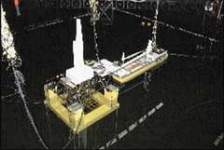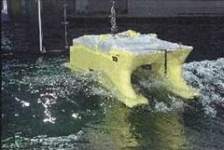NETHERLANDS: Deepwater model testing and engineering tools
April 2001 Vol. 222 No. 4 Feature Article THE NETHERLANDS: Deepwater model testing and engineering tools The Maritime Research Institute Netherlands (MARIN) is
THE NETHERLANDS:Deepwater model testing and engineering toolsThe Maritime Research Institute Netherlands (MARIN) is moving forward with two technical services – a new offshore test basin and an engineering "toolbox." Offshore Test Basin Since opening its new offshore test basin in July last year, MARIN has attracted significant interest from the offshore industry because of the basin’s unique wind, wave and current generation capabilities. Some interesting projects are described below. Seno TLP. Unocal Corp., with its West Seno tension leg platform, was the first commercial client in the new offshore test basin. Model tests included evaluations of the TLP alone and with a drilling tender barge moored to it. Objectives were to obtain sufficient data to verify TLP performance and to confirm motions of the moored barge relative to the TLP. The unique, deep pit in the offshore basin allowed for the testing of a 1:50 scale model of the full-length TLP tendon.
Tension leg deck tests. Single Buoy Mooring (SBM) is developing its tension leg deck (TLD) concept for deepwater developments. Using an ingenious system of free-hanging weights, a stable platform for vertical risers can be created on a moving barge. As part of this development, MARIN performed model tests on a rectangular barge with different skirt configurations to obtain realistic values of the viscous damping in heave and roll. These tests did not show any sign of parametric rolling, even in very large beam waves. Twin-hull intervention vessel. Providing a stable platform in severe environmental conditions is the most important feature of intervention vessels. Therefore, Maritime Tentech is designing a new-concept, twin-hull intervention vessel (THIV) for its client Odfjell Drilling. Specially shaped columns and pontoons optimize the motions of the structure in waves. Tests were performed in severe sea states to investigate vessel motions, minimum air-gap and slamming. Using a special force and moment frame, the splitting forces could also be measured in 6_ of freedom. The results showed very favorable motion behavior, even under these extreme conditions.
Offshore Numerical Toolbox MARIN’s suite of offshore simulation programs has become a genuine numerical "toolbox" with "hammers and screwdrivers" for everyday problems, and "adjustable wrenches" for the more complex ones. But experienced and creative engineers remain indispensable. Some examples of their roles in the innovative offshore industry follow. Platform removal vessel Pieter Schelte. To answer the decommissioning problem of offshore platforms, MARIN helped Excalibur Engineering develop the Pieter Schelte, a vessel designed to remove topsides and steel jacket structures in a single lift. Using two coupled tanker hulls, the vessel is somewhat similar to a huge offshore fork-lift truck. To optimize the vessel, with its complex mooring and lifting system, Excalibur needed reliable advice on motions and mooring loads. Using the DIFFRAC and LIFSIM programs, combined-wave and low-frequency motions were studied for both stand-off and lifting conditions. Because accurate results (parallel to the numerical study) were required, model tests were carried out to verify damping and motion levels. Loads in the two coupled hulls were also studied. King size heavy-lift vessel. To assist deepwater offshore developments, Dockwise is considering building a king-size heavy-lift vessel (KSHLV) to transport large floating offshore structures, such as FPSOs and Spars. Because of the vessel’s size and cargo, loading and offloading operations will take place in coastal waters by submerging the KSHLV and floating the cargo on and off the vessel. MARIN assisted in the KSHLV conceptual design. After studying the problems of multiple-body diffraction analysis for two bodies in close proximity, a simulation model of the KSHLV and its cargo were developed in LIFSIM, and the motions and contact loads during the float-off were studied. This gave important initial insights into the vessel’s behavior. To improve the predictions’ reliability, dedicated model tests are now being considered to obtain reliable damping coefficients and to verify (relative) motions and drift forces. Belanak FPSO motions and downtime. As part of
the Belanak FPSO design process, Aker Maritime evaluated roll and pitch motions and resultant effects
on the LPG fractionation tower’s downtime. MARIN determined the viscous roll damping from a diffraction
analysis in DIFFRAC. The DYNFLOAT program also takes into account the damping of the mooring lines and risers.
Finally, a downtime analysis was carried out, providing an opportunity to evaluate and optimize the design
based on real operational numbers. |




